Brzesko – grave no 1 / no 2
Borough of Brzesko, Brzesko District, Małopolskie VoivodshipType of place
The Jewish Cemetery in Brzesko.Information about the crime
On 13 April 1942 the Gestapo and military police murdered 50 Jews. The victims were buried in two mass graves, 25 people in each of them; their dimensions were 4 x 5 metres.
On 18 June 1942 the Gestapo and military police murdered 200 Jews. A document taken from the archive of the the Regional Commission for the Examination of Crimes against the Polish Nation (a file, Brzesko District, surveys, 1968, Brzesko District’s citizens who died within the area of Brzesko District, Krakowskie Voivodeship – IPN Kr 1/1312/2) mentions the following names of Jews who on that day, i.e. 18 June 1942, were shot to death in Brzesko: Strauber Chaim /Zygmunt/, Schmaus H. – Doctor of Law, judge, Sttiel M. – Doctor of Medicine, Sttiel Ch. – dentist and secondary school pupils: Birnbaum, Eliasz, Brandstatter Ewa, Brandstatter Leja, Brandstatter Dwoira, Blonder Maks, Blum Artur, Bien-Stock Sara, Beider Bela, Blonder Chaja, Borgenicht Hinda, Deiches Jerzy, Einchorn Malka, Einchorm Beniamin, Frendlich Jozef, Fruchman Regina, Furst Laura, Furst Marian, Furst Estera, Gartenberg Selda, Geltberger Leon, Gerberger Chaim, Goldman Ryfka, Goldman Berta, Goldstein Mendel, Grun Mojżesz, Grunbaum Zofia, Hofstadter Szyja, Hofstadter Sara, Jakubowicz Szymon, Jakubowicz Emil, Kanner Aaron, Kanner Leib, Klapholtz Gustaw, Kaffer Gitla, Kleinberger Chana, Klauter Herman, Loffel-Holtz Juda, Loffel-Holtz Juda, Loffelholtz Regina, Langsdorf Chaim, Lindner Anna, Peltz Hirsh, Pomeranz Benzion, Reibach Bronisław, Riegelhaupt Lazar, Rothkopf Chaja, Schapira Jakub, Schiff Samuel, Schnur Mendel, Siedlisker Ekiwa, Stinlauf Mendel, Stinlauf Herman, Stinlauf Arie Leib, Sibermann Chane, Spelmann Rachela, Schindler Estera, Theemann Anna, Theemann Wolf, Ullmann Estera, Weinbrener Kazimiera and Weinbrener Lidia.
There were doubts surrounding the circumstances of the death of the Theemann siblings, Anna and Wolf. Out of the large Theeman family (parents and six children) only the mother, Sabina, survived. According to the information gathered by the Foundation, Wolf Theeman was born in Brzesko in 1919 and Andzia (Anna) in 1915. Thus it was impossible they were secondary school pupils in 1942. According to the account given by one of Brzesko citizens, the whole Theeman family (apart from Sabina who was hiding under a false identity) was epelled from Brzesko during one of the genocide operations.
On 22 December 1942 the Gestapo and military police murdered several dozen Jews, including: Apel Chaim (son), Apel Dora (mother), Apel Herman (son), Apel Jakub (father), Apel Mendel (son), Ebenholz Chaim, Ebenholz Mendel, Mikołajewicz Regina, Mikołajewicz Tobiasz. Bodies of the victims were buried on the cemetery.
The history of the ghetto in Zakliczyn is connected with the Jewish cemetery in Brzesko. In 1941 during a fair in Zakliczyn a German military policeman murdered two Jewish women. Their bodies were transported to Brzesko and buried at the cemetery. Apart from that, on the Jewish cemetery in Brzesko there is a mass grave of Jewish men, women and children from the ghetto in Zakliczyn who were murdered in December 1942 and buried at the site of the execution. In 1947 bodies of the victims were exhumed and moved to Brzesko.
Commemoration
One of the mass graves has been commemorated by Ms Anna Brzeska, a local activist. On the other grave there is a symbolic wooden matzevah put up as a part of a project whose objective was to mark 30 places of the Holocaust in southern and eastern Poland; it was done in September 2017 in cooperation with the American Matzevah Foundation.

IDENTIFICATION OF THE GRAVE BASED ON NON INVASIVE RESEARCH
On the 17th of May 2017 a GPR survey of two neighboring locations was carried out (GPS:1. N49°58.433’E020°36.401′, 2. N49°58.431’E020°36.411′). In both sites the radar indicated ground disturbance that most likely represents the mass graves. Approximate format of the registered anomalies are: 1. length approx. 4.0 m, width approx. 2.0 m, depth approx. 1.0 m, 2. length approx. 12.0 m, width approx. 12.0 m. 2.0 m, depth approx. 1.0 – 1.2 m. The approximate location of the grave site was confirmed by an eyewitness.
The LIDAR survey indicates a considerable ground depression at the site of the second grave.
The aerial photography query for this area wasn’t ordered.
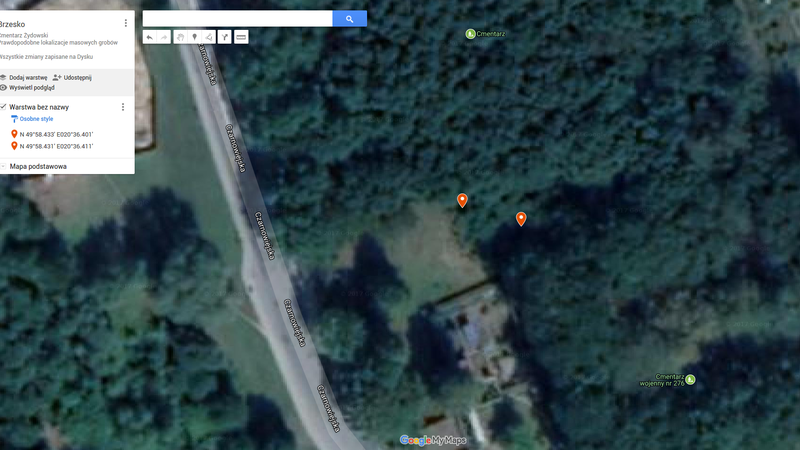 Brzesko grób nr.1/2 fotografia sateliatrna 3
Brzesko grób nr.1/2 fotografia sateliatrna 3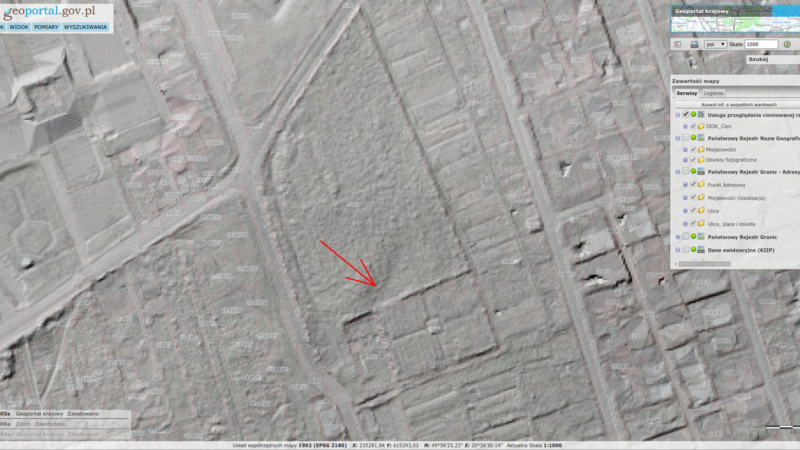 Brzesko grób nr.1/2 lidar 1c
Brzesko grób nr.1/2 lidar 1c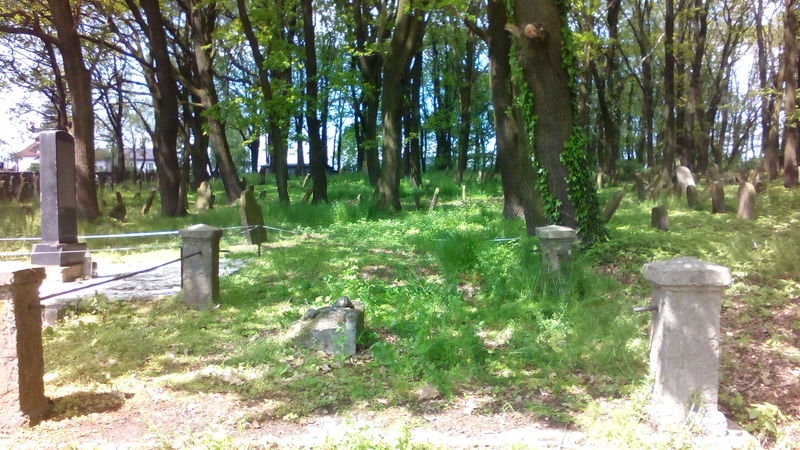 Brzesko grób nr.1/nr.2 fotografia 1 lokalizacji 1
Brzesko grób nr.1/nr.2 fotografia 1 lokalizacji 1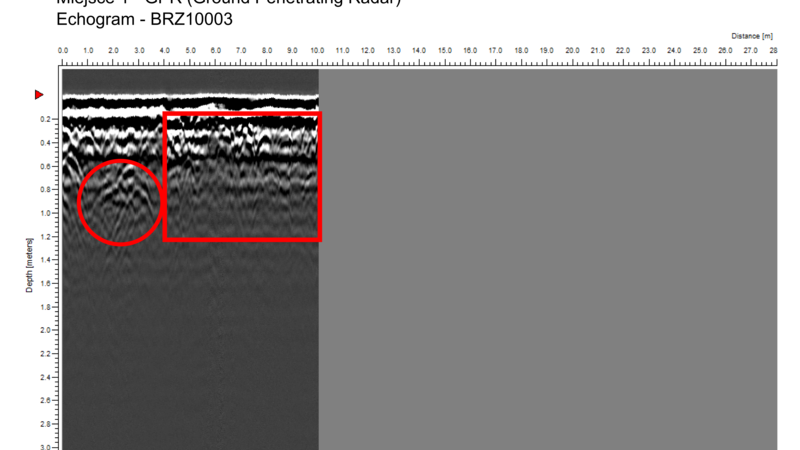 Brzesko grób nr.1 BRZ10003a
Brzesko grób nr.1 BRZ10003aSources
Contact and cooperation
We are still looking for information on the identity of the victims and the location of Jewish graves in Brzesko. If you know something more, write to us at the following address: fundacjazapomniane@gmail.com.
Bibliography
GK 163/8. Questionnaire. Executions. Graves. Krakow Province, vol. I, Questionnaires about mass executions and mass graves – Krakow province.
GK 185/7. A list of the places of executions and injured persons in the Krakow province during World War II (lists, correspondence, questionnaires).
Record from the thematic file of the Chief Commission for the Examination of German Crimes in Poland.
The register of sites and crimes committed by the Germans in Poland between 1939 and 1945, Krakow province, Warsaw 1975, p. 33- 35.
IPN Kr 1/1276. Questionnaires. Districts: Bochnia, Brzesko.
IPN BU 2448/426. Questionnaires the Chief Commission for the Examination of German Crimes in Poland and The Regional Commission for the Examination of German Crimes in Warsaw, collected in 1968-1972. Questionnaires regarding Krakow province – VII. Brzesko district: questionnaires.
IPN Kr 1/1312/2. Brzesko district.
IPN Kr 1/1299. Districts: Bochnia, Brzesko, Chrzanów, Dąbrowa Tarnowska, Jaworzno, Kraków, Miechów, Nowy Sącz, Sucha Beskidzka, Tarnów, Żywiec – information on executions.
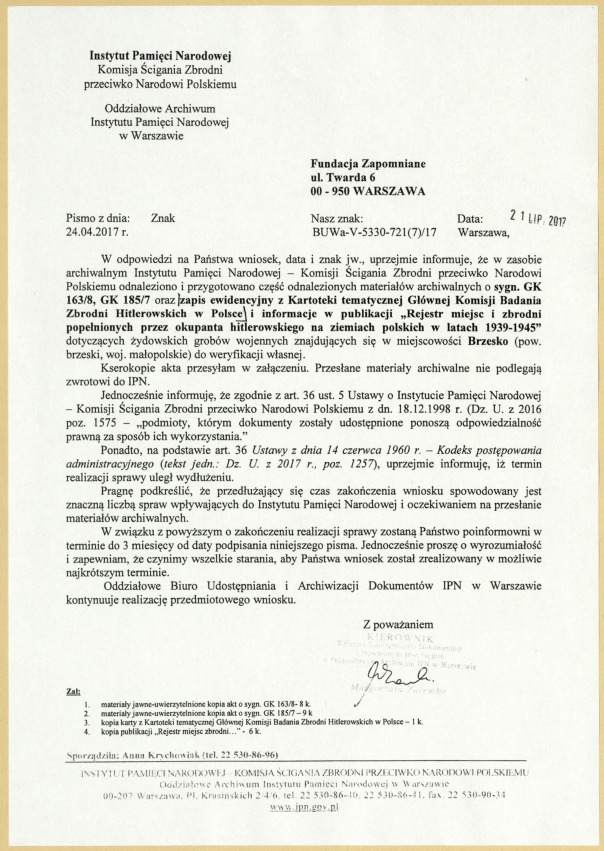 [Zestawienie miejsc straceń oraz osób poszkodowanych na terenie województwa krakowskiego w czasie II wojny światowej
[Zestawienie miejsc straceń oraz osób poszkodowanych na terenie województwa krakowskiego w czasie II wojny światowej